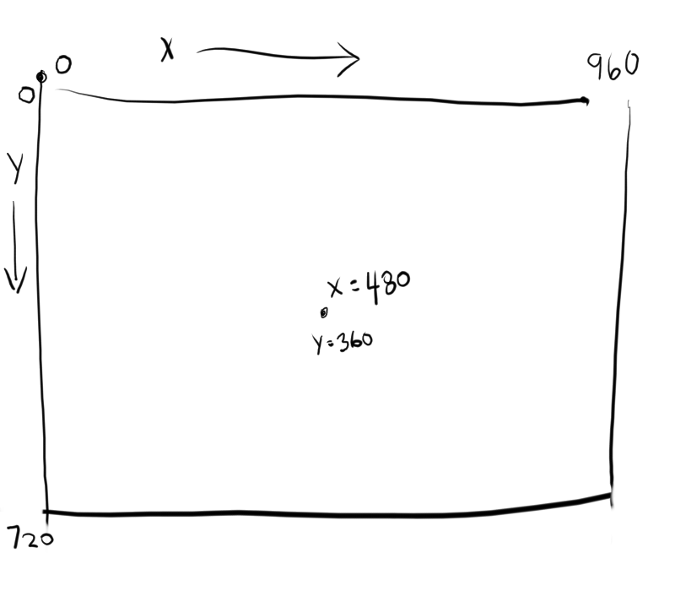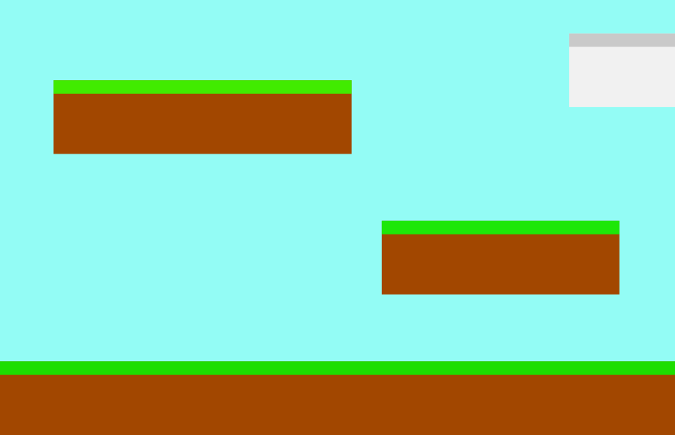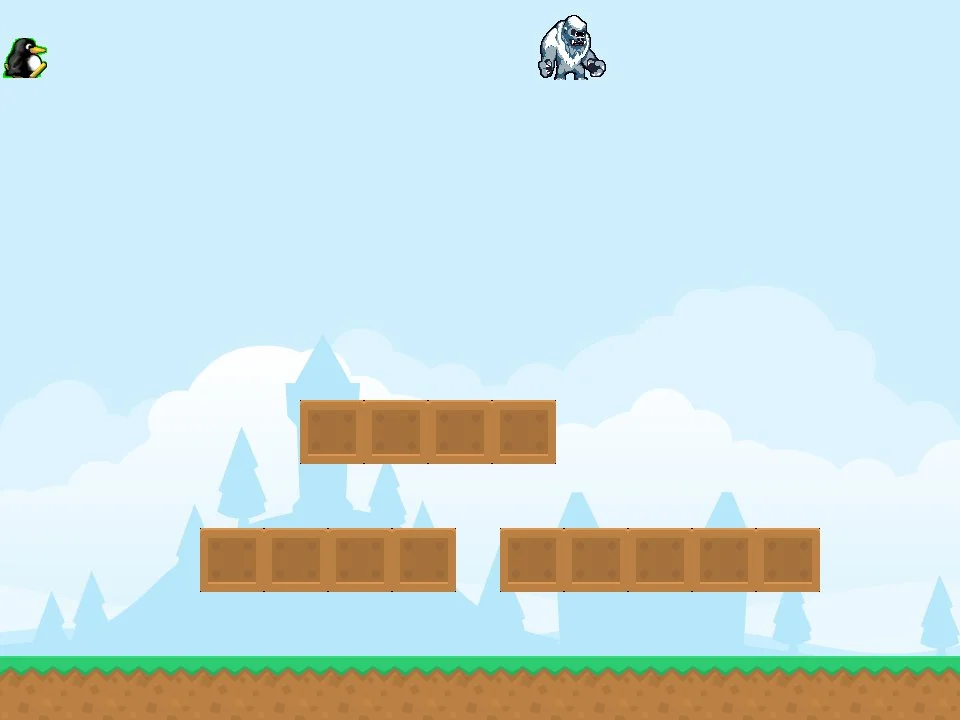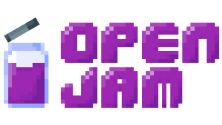This is part 6 in an ongoing series about creating video games in Python 3 using the Pygame module. Previous articles are:
- Learn how to program in Python by building a simple dice game
- Build a game framework with Python using the Pygame module
- How to add a player to your Python game
- Using Pygame to move your game character around
- What's a hero without a villain? How to add one to your Python game
A platformer game needs platforms.
In Pygame, the platforms themselves are sprites, just like your playable sprite. That's important because having platforms that are objects makes it a lot easier for your player sprite to interact with them.
There are two major steps in creating platforms. First, you must code the objects, and then you must map out where you want the objects to appear.
Coding platform objects
To build a platform object, you create a class called Platform. It's a sprite, just like your Player sprite, with many of the same properties.
Your Platform class needs to know a lot of information about what kind of platform you want, where it should appear in the game world, and what image it should contain. A lot of that information might not even exist yet, depending on how much you have planned out your game, but that's all right. Just as you didn't tell your Player sprite how fast to move until the end of the Movement article, you don't have to tell Platform everything upfront.
In the objects section of your script, create a new class:
# x location, y location, img width, img height, img file
class Platform(pygame.sprite.Sprite):
def __init__(self, xloc, yloc, imgw, imgh, img):
pygame.sprite.Sprite.__init__(self)
self.image = pygame.image.load(os.path.join('images', img)).convert()
self.image.convert_alpha()
self.image.set_colorkey(ALPHA)
self.rect = self.image.get_rect()
self.rect.y = yloc
self.rect.x = xloc
When called, this class creates an object onscreen in some X and Y location, with some width and height, using some image file for texture. It's very similar to how players or enemies are drawn onscreen. You probably recognize this same code structure from the Player and Enemy classes.
Types of platforms
The next step is to map out where all your platforms need to appear.
The tile method
There are a few different ways to implement a platform game world. In the original side-scroller games, such as Mario Super Bros. and Sonic the Hedgehog, the technique was to use "tiles," meaning that there were a few blocks to represent the ground and various platforms, and these blocks were used and reused to make a level. You have only eight or 12 different kinds of blocks, and you line them up onscreen to create the ground, floating platforms, and whatever else your game needs. Some people find this the easier way to make a game since you just have to make (or download) a small set of level assets to create many different levels. The code, however, requires a little more math.

SuperTux, a tile-based video game.
The hand-painted method
Another method is to make each and every asset as one whole image. If you enjoy creating assets for your game world, this is a great excuse to spend time in a graphics application, building each and every part of your game world. This method requires less math, because all the platforms are whole, complete objects, and you tell Python where to place them onscreen.
Each method has advantages and disadvantages, and the code you must use is slightly different depending on the method you choose. I'll cover both so you can use one or the other, or even a mix of both, in your project.
Level mapping
Mapping out your game world is a vital part of level design and game programming in general. It does involve math, but nothing too difficult, and Python is good at math so it can help some.
You might find it helpful to design on paper first. Get a sheet of paper and draw a box to represent your game window. Draw platforms in the box, labeling each with its X and Y coordinates, as well as its intended width and height. The actual positions in the box don't have to be exact, as long as you keep the numbers realistic. For instance, if your screen is 720 pixels wide, then you can't fit eight platforms at 100 pixels each all on one screen.
Of course, not all platforms in your game have to fit in one screen-sized box, because your game will scroll as your player walks through it. So keep drawing your game world to the right of the first screen until the end of the level.
If you prefer a little more precision, you can use graph paper. This is especially helpful when designing a game with tiles because each grid square can represent one tile.

Coordinates
You may have learned in school about the Cartesian coordinate system. What you learned applies to Pygame, except that in Pygame, your game world's coordinates place 0,0 in the top-left corner of your screen instead of in the middle, which is probably what you're used to from Geometry class.

Example of coordinates in Pygame.
The X axis starts at 0 on the far left and increases infinitely to the right. The Y axis starts at 0 at the top of the screen and extends down.
Image sizes
Mapping out a game world is meaningless if you don't know how big your players, enemies, and platforms are. You can find the dimensions of your platforms or tiles in a graphics program. In Krita, for example, click on the Image menu and select Properties. You can find the dimensions at the very top of the Properties window.
Alternately, you can create a simple Python script to tell you the dimensions of an image. To do that, you must install a Python module called Pillow, which provides the Python Image Library (PIL). Add Pillow to your project's requirements.txt file:
pygame~=1.9.6
PillowCreate a new Python file in PyCharm and name it identify. Type this code into it:
#!/usr/bin/env python3
# GNU All-Permissive License
# Copying and distribution of this file, with or without modification,
# are permitted in any medium without royalty provided the copyright
# notice and this notice are preserved. This file is offered as-is,
# without any warranty.
from PIL import Image
import os.path
import sys
if len(sys.argv) > 1:
print(sys.argv[1])
else:
sys.exit('Syntax: identify.py [filename]')
pic = sys.argv[1]
img = Image.open(pic)
X = img.size[0]
Y = img.size[1]
print(X, Y)
Click on the Terminal tab at the bottom of the PyCharm window to open a terminal within your virtual environment. Now you can install the Pillow module into your environment:
(venv) pip install -r requirements.txt
Requirement already satisfied: pygame~=1.9.6 [...]
Installed Pillow [...]Once that is installed, run your script from within your game project directory:
(venv) python ./identify.py images/ground.png
(1080, 97)The image size of the ground platform in this example is 1080 pixels wide and 97 high.
Platform blocks
If you choose to draw each asset individually, you must create several platforms and any other elements you want to insert into your game world, each within its own file. In other words, you should have one file per asset, like this:

One image file per object.
You can reuse each platform as many times as you want, just make sure that each file only contains one platform. You cannot use a file that contains everything, like this:

Your level cannot be one image file.
You might want your game to look like that when you've finished, but if you create your level in one big file, there is no way to distinguish a platform from the background, so either paint your objects in their own file or crop them from a large file and save individual copies.
Note: As with your other assets, you can use GIMP, Krita, MyPaint, or Inkscape to create your game assets.
Platforms appear on the screen at the start of each level, so you must add a platform function in your Level class. The special case here is the ground platform, which is important enough to be treated as its own platform group. By treating the ground as its own special kind of platform, you can choose whether it scrolls or whether it stands still while other platforms float over the top of it. It's up to you.
Add these two functions to your Level class:
def ground(lvl,x,y,w,h):
ground_list = pygame.sprite.Group()
if lvl == 1:
ground = Platform(x,y,w,h,'block-ground.png')
ground_list.add(ground)
if lvl == 2:
print("Level " + str(lvl) )
return ground_list
def platform( lvl ):
plat_list = pygame.sprite.Group()
if lvl == 1:
plat = Platform(200, worldy-97-128, 285,67,'block-big.png')
plat_list.add(plat)
plat = Platform(500, worldy-97-320, 197,54,'block-small.png')
plat_list.add(plat)
if lvl == 2:
print("Level " + str(lvl) )
return plat_listThe ground function requires an X and Y location so Pygame knows where to place the ground platform. It also requires the width and height of the platform so Pygame knows how far the ground extends in each direction. The function uses your Platform class to generate an object onscreen, and then adds that object to the ground_list group.
The platform function is essentially the same, except that there are more platforms to list. In this example, there are only two, but you can have as many as you like. After entering one platform, you must add it to the plat_list before listing another. If you don't add a platform to the group, then it won't appear in your game.
Tip: It can be difficult to think of your game world with 0 at the top, since the opposite is what happens in the real world; when figuring out how tall you are, you don't measure yourself from the sky down, you measure yourself from your feet to the top of your head.
If it's easier for you to build your game world from the "ground" up, it might help to express Y-axis values as negatives. For instance, you know that the bottom of your game world is the value of
worldy. Soworldyminus the height of the ground (97, in this example) is where your player is normally standing. If your character is 64 pixels tall, then the ground minus 128 is exactly twice as tall as your player. Effectively, a platform placed at 128 pixels is about two stories tall, relative to your player. A platform at -320 is three more stories. And so on.
As you probably know by now, none of your classes and functions are worth much if you don't use them. Add this code to your setup section:
ground_list = Level.ground(1, 0, worldy-97, 1080, 97)
plat_list = Level.platform(1)And add these lines to your main loop (again, the first line is just for context):
enemy_list.draw(world) # refresh enemies
ground_list.draw(world) # refresh ground
plat_list.draw(world) # refresh platformsTiled platforms
Tiled game worlds are considered easier to make because you just have to draw a few blocks upfront and can use them over and over to create every platform in the game. There are sets of tiles with a Creative Commons license for you to use on sites like kenney.nl and OpenGameArt.org. The simplified-platformer-pack from kenney.nl are 64 pixels square, so that's the dimension for tiles this article uses. Should you download or create tiles with a different size, adjust the code as needed.
The Platform class is the same as the one provided in the previous sections.
The ground and platform in the Level class, however, must use loops to calculate how many blocks to use to create each platform.
If you intend to have one solid ground in your game world, the ground is simple. You just "clone" your ground tile across the whole window. For instance, you could create a list of X and Y values to dictate where each tile should be placed, and then use a loop to take each value and draw one tile. This is just an example, so don't add this to your code:
# Do not add this to your code
gloc = [0,656,64,656,128,656,192,656,256,656,320,656,384,656]If you look carefully, though, you can see all the Y values are always the same (656, to be specific), and the X values increase steadily in increments of 64, which is the size of the tile. That kind of repetition is exactly what computers are good at, so you can use a little bit of math logic to have the computer do all the calculations for you:
Add this to the setup part of your script:
gloc = []
tx = 64
ty = 64
i=0
while i <= (worldx/tx)+tx:
gloc.append(i*tx)
i=i+1
ground_list = Level.ground( 1,gloc,tx,ty )With this code, regardless of the size of your window, Python divides the width of the game world by the width of the tile and creates an array listing each X value. This doesn't calculate the Y value, but that never changes on flat ground anyway.
To use the array in a function, use a while loop that looks at each entry and adds a ground tile at the appropriate location. Add this function to your Level class:
def ground(lvl,gloc,tx,ty):
ground_list = pygame.sprite.Group()
i=0
if lvl == 1:
while i < len(gloc):
ground = Platform(gloc[i],worldy-ty,tx,ty,'tile-ground.png')
ground_list.add(ground)
i=i+1
if lvl == 2:
print("Level " + str(lvl) )
return ground_listThis is nearly the same code as the ground function for the block-style platformer, provided in the previous section, aside from the while loop.
For moving platforms, the principle is similar, but there are some tricks you can use to make your life easier.
Rather than mapping every platform by pixels, you can define a platform by its starting pixel (its X value), the height from the ground (its Y value), and how many tiles to draw. That way, you don't have to worry about the width and height of every platform.
The logic for this trick is a little more complex, so copy this code carefully. There is a while loop inside of another while loop because this function must look at all three values within each array entry to successfully construct a full platform. In this example, there are only three platforms defined as ploc.append statements, but your game probably needs more, so define as many as you need. Of course, some won't appear yet because they're far offscreen, but they'll come into view once you implement scrolling.
def platform(lvl,tx,ty):
plat_list = pygame.sprite.Group()
ploc = []
i=0
if lvl == 1:
ploc.append((200,worldy-ty-128,3))
ploc.append((300,worldy-ty-256,3))
ploc.append((500,worldy-ty-128,4))
while i < len(ploc):
j=0
while j <= ploc[i][2]:
plat = Platform((ploc[i][0]+(j*tx)),ploc[i][1],tx,ty,'tile.png')
plat_list.add(plat)
j=j+1
print('run' + str(i) + str(ploc[i]))
i=i+1
if lvl == 2:
print("Level " + str(lvl) )
return plat_listOf course, this has only created a function to calculate platforms for each level. You code doesn't invoke the function yet.
In the setup section of your program, add this line:
plat_list = Level.platform(1, tx, ty)To get the platforms to appear in your game world, they must be in your main loop. If you haven't already done so, add these lines to your main loop (again, the first line is just for context):
enemy_list.draw(world) # refresh enemies
ground_list.draw(world) # refresh ground
plat_list.draw(world) # refresh platformsLaunch your game, and adjust the placement of your platforms as needed. Don't worry that you can't see the platforms that are spawned offscreen; you'll fix that soon.

Applying what you know
I haven't demonstrated how to place your enemy in your game world, but apply what you've learnt so far to position the enemy sprite either on a platform or down on the ground.
Don't position your hero sprite yet. That must be managed by the forces of gravity (or at least an emulation of it), which you'll learn in the next two articles.
For now, here's the code so far:
#!/usr/bin/env python3
# by Seth Kenlon
# GPLv3
# This program is free software: you can redistribute it and/or
# modify it under the terms of the GNU General Public License as
# published by the Free Software Foundation, either version 3 of the
# License, or (at your option) any later version.
#
# This program is distributed in the hope that it will be useful, but
# WITHOUT ANY WARRANTY; without even the implied warranty of
# MERCHANTABILITY or FITNESS FOR A PARTICULAR PURPOSE. See the GNU
# General Public License for more details.
#
# You should have received a copy of the GNU General Public License
# along with this program. If not, see <https://www.gnu.org/licenses/>.
import pygame
import sys
import os
'''
Variables
'''
worldx = 960
worldy = 720
fps = 40
ani = 4
world = pygame.display.set_mode([worldx, worldy])
BLUE = (25, 25, 200)
BLACK = (23, 23, 23)
WHITE = (254, 254, 254)
ALPHA = (0, 255, 0)
'''
Objects
'''
# x location, y location, img width, img height, img file
class Platform(pygame.sprite.Sprite):
def __init__(self, xloc, yloc, imgw, imgh, img):
pygame.sprite.Sprite.__init__(self)
self.image = pygame.image.load(os.path.join('images', img)).convert()
self.image.convert_alpha()
self.image.set_colorkey(ALPHA)
self.rect = self.image.get_rect()
self.rect.y = yloc
self.rect.x = xloc
class Player(pygame.sprite.Sprite):
"""
Spawn a player
"""
def __init__(self):
pygame.sprite.Sprite.__init__(self)
self.movex = 0
self.movey = 0
self.frame = 0
self.health = 10
self.images = []
for i in range(1, 5):
img = pygame.image.load(os.path.join('images', 'hero' + str(i) + '.png')).convert()
img.convert_alpha()
img.set_colorkey(ALPHA)
self.images.append(img)
self.image = self.images[0]
self.rect = self.image.get_rect()
def control(self, x, y):
"""
control player movement
"""
self.movex += x
self.movey += y
def update(self):
"""
Update sprite position
"""
self.rect.x = self.rect.x + self.movex
self.rect.y = self.rect.y + self.movey
# moving left
if self.movex < 0:
self.frame += 1
if self.frame > 3 * ani:
self.frame = 0
self.image = pygame.transform.flip(self.images[self.frame // ani], True, False)
# moving right
if self.movex > 0:
self.frame += 1
if self.frame > 3 * ani:
self.frame = 0
self.image = self.images[self.frame // ani]
hit_list = pygame.sprite.spritecollide(self, enemy_list, False)
for enemy in hit_list:
self.health -= 1
print(self.health)
class Enemy(pygame.sprite.Sprite):
"""
Spawn an enemy
"""
def __init__(self, x, y, img):
pygame.sprite.Sprite.__init__(self)
self.image = pygame.image.load(os.path.join('images', img))
self.image.convert_alpha()
self.image.set_colorkey(ALPHA)
self.rect = self.image.get_rect()
self.rect.x = x
self.rect.y = y
self.counter = 0
def move(self):
"""
enemy movement
"""
distance = 80
speed = 8
if self.counter >= 0 and self.counter <= distance:
self.rect.x += speed
elif self.counter >= distance and self.counter <= distance * 2:
self.rect.x -= speed
else:
self.counter = 0
self.counter += 1
class Level:
def ground(lvl, gloc, tx, ty):
ground_list = pygame.sprite.Group()
i = 0
if lvl == 1:
while i < len(gloc):
ground = Platform(gloc[i], worldy - ty, tx, ty, 'tile-ground.png')
ground_list.add(ground)
i = i + 1
if lvl == 2:
print("Level " + str(lvl))
return ground_list
def bad(lvl, eloc):
if lvl == 1:
enemy = Enemy(eloc[0], eloc[1], 'enemy.png')
enemy_list = pygame.sprite.Group()
enemy_list.add(enemy)
if lvl == 2:
print("Level " + str(lvl))
return enemy_list
# x location, y location, img width, img height, img file
def platform(lvl, tx, ty):
plat_list = pygame.sprite.Group()
ploc = []
i = 0
if lvl == 1:
ploc.append((200, worldy - ty - 128, 3))
ploc.append((300, worldy - ty - 256, 3))
ploc.append((500, worldy - ty - 128, 4))
while i < len(ploc):
j = 0
while j <= ploc[i][2]:
plat = Platform((ploc[i][0] + (j * tx)), ploc[i][1], tx, ty, 'tile.png')
plat_list.add(plat)
j = j + 1
print('run' + str(i) + str(ploc[i]))
i = i + 1
if lvl == 2:
print("Level " + str(lvl))
return plat_list
'''
Setup
'''
backdrop = pygame.image.load(os.path.join('images', 'stage.png'))
clock = pygame.time.Clock()
pygame.init()
backdropbox = world.get_rect()
main = True
player = Player() # spawn player
player.rect.x = 0 # go to x
player.rect.y = 30 # go to y
player_list = pygame.sprite.Group()
player_list.add(player)
steps = 10
eloc = []
eloc = [300, 0]
enemy_list = Level.bad(1, eloc)
gloc = []
tx = 64
ty = 64
i = 0
while i <= (worldx / tx) + tx:
gloc.append(i * tx)
i = i + 1
ground_list = Level.ground(1, gloc, tx, ty)
plat_list = Level.platform(1, tx, ty)
'''
Main Loop
'''
while main:
for event in pygame.event.get():
if event.type == pygame.QUIT:
pygame.quit()
try:
sys.exit()
finally:
main = False
if event.type == pygame.KEYDOWN:
if event.key == ord('q'):
pygame.quit()
try:
sys.exit()
finally:
main = False
if event.key == pygame.K_LEFT or event.key == ord('a'):
player.control(-steps, 0)
if event.key == pygame.K_RIGHT or event.key == ord('d'):
player.control(steps, 0)
if event.key == pygame.K_UP or event.key == ord('w'):
print('jump')
if event.type == pygame.KEYUP:
if event.key == pygame.K_LEFT or event.key == ord('a'):
player.control(steps, 0)
if event.key == pygame.K_RIGHT or event.key == ord('d'):
player.control(-steps, 0)
world.blit(backdrop, backdropbox)
player.update()
player_list.draw(world)
enemy_list.draw(world)
ground_list.draw(world)
plat_list.draw(world)
for e in enemy_list:
e.move()
pygame.display.flip()
clock.tick(fps)








6 Comments